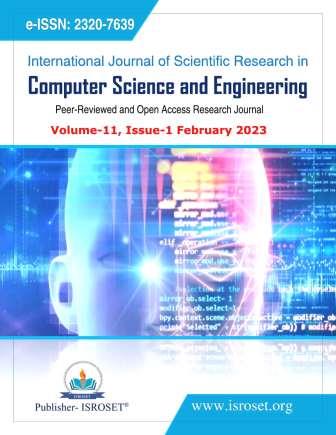Modelling and Assessment of the Star Network Topology Using OPNET Simulation Techniques
Keywords:
FTP, Network Delay, Network Load, OPNET Simulator, Response Time, Star Network, Traffic ReceivedAbstract
The behaviour of many topological types is explained by a variety of advantages and disadvantages. When constructing a local area network for an organization, the types of data distribution topologies chosen significantly impact the network. The OPNET simulator was used in this study to evaluate a star network architecture for various network sizes and analyze network performance. As the characteristics evaluated differ depending on how many nodes were attached to a particular switch, four scenarios were created for this design with node counts of 10, 20, 30, and 40, respectively. This was accomplished by increasing the nodes and then altering a few parameters. This study investigated network delay (seconds), load (bits/second), traffic delivered (packets/second), received (packets/second), and response times. The two applications examined were FTP (File Transfer Protocol) and a database. Using this topology, performance across various network sizes is compared. However, since the central switch can accommodate more nodes, an increase in response time may be expected as network capacity increases and both traffic transmitted and traffic received (packets/sec) increase. Given that this switch is an Ethernet 128 Switch Advanced, it is clear that the network`s performance can be impacted by the central switch that is employed.
References
S. S. Rai1, A.T. Gaikwad, R.V. Kulkarni, “A Research Paper on Simulation Model for Teaching and Learning Process in Higher Education.”International Journal of Advanced Computer Research Vol.4, No.2, pp. 582-587, 2014.
A.A.Atayero, A.S.Alatishe, J.O.Iruemi, “Modeling and Simulation of a University LAN in OPNET Modeller Environment”, Department of Electrical and Information Engineering, Covenant University, Nigeria, pp1-4, 2012.
P.L.Francis, “A Review-Analysis of Network Topologies for Microenterprises,” Advanced Science and Technology Letters, Vol.135, pp.175-180, 2016.
M. Sparsh, “OPNET: An Integrated Design Paradigm for Simulations. Software Engineering,” An International Journal, Vol.2, No.2, pp.57-67, 2012.
A. Nurul, J.A. Mohammad, A. Tasnuva, “Performance Study of Star Topology in Small Internetworks,” International Journal of Computer Applications (0975 – 8887) Vol.107, No.2, pp.45-53, 2014.
J. Garima, N. Nasreen, K. Nisha, S. Sourabh, “Designing & Simulation of Topology Network using Packet Tracer,” International Research Journal of Engineering and Technology (IRJET), Vol.2, Issue 2, pp.793-795, 2015.
S. Pankaj, V. Shubham, “Network Topologies”, IJRDO - Journal of Computer Science Engineering, Maharishi Dayanand University Gurgaon,Haryana, India, Vol.1, ISSN: 2456-1843, pp.1-9, 2015.
P.L.Francis,“A Review-Analysis of Network Topologies for Microenterprises,” Advanced Science and Technology Letters, Vol.135, pp.175-180 2016.
R.S. Ranjeet, “Simulation and Implementation of Network Topology Using NS2” http: // www.ijesrt.com© International Journal of Engineering Sciences & Research Technology, ISSN: 2277-9655, pp.291-295, 2016.
N.H. Waleed, A. M. Ali, A.T. Duaa, H.S. Raed, “A Simulation of Wireless Sensor Network Using ZigBee,” Computer Engineering and Intelligent Systems, Vol.8, No.3, pp. 23-27, 2017.
C. Gürcan, G. Hüseyin, O.D. Mehmet. “Performance Analysis of ZigBee Protocol in the LargeScale Network Topologies”, International Journal of Computer Applications (0975 – 8887), Vol.181, pp. 11-15, 2018.
N.Q. Noor, R. M. Z. Subhi, K.H. Bzar, “Opnet Based Performance Analysis and Comparison among Different Physical Network Topologies,” Academic Journal of Nawroz University (AJNU), pp. 48-54, 2018.
Q.A.A. Ruhimat, G.W.Fajariyanto, D.M.Firmansyah, Slamin, “Optimal computer network based on graph topology model, IOP Conf. Series,” Journal of Physics: Conf. Series 1211, pp. 1-8, 2019.
O.J. Adaramola, J.R. Olasina, “Network Model Analysis in Opnet Simulation,” International Journal of Engineering Applied Sciences and Technology, 2020 Vol.5, Issue 1, ISSN No. 2455-2143, pp.47-51, 2020.
Downloads
Published
How to Cite
Issue
Section
License

This work is licensed under a Creative Commons Attribution 4.0 International License.
Authors contributing to this journal agree to publish their articles under the Creative Commons Attribution 4.0 International License, allowing third parties to share their work (copy, distribute, transmit) and to adapt it, under the condition that the authors are given credit and that in the event of reuse or distribution, the terms of this license are made clear.







